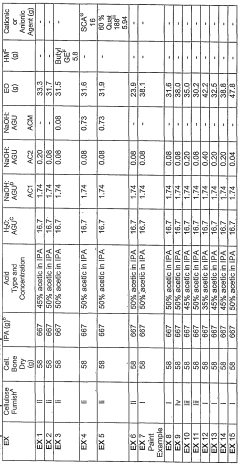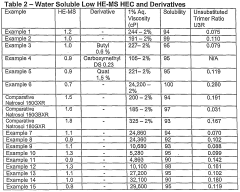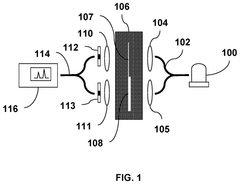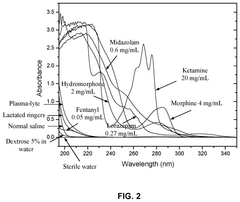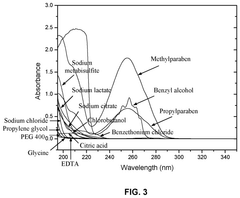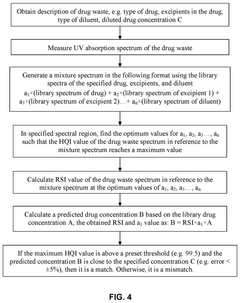Investigating Hydroxyethylcellulose Use in Drug Smuggling Detection
JUL 31, 20259 MIN READ
Generate Your Research Report Instantly with AI Agent
Patsnap Eureka helps you evaluate technical feasibility & market potential.
HEC Detection Background
Hydroxyethylcellulose (HEC) has emerged as a substance of interest in the field of drug smuggling detection due to its unique properties and potential applications. This cellulose derivative, commonly used in various industries, has gained attention from law enforcement agencies and forensic scientists for its role in concealing illicit substances.
The background of HEC detection in drug smuggling can be traced back to the early 2000s when authorities first encountered its use as a masking agent. Drug traffickers discovered that HEC could be utilized to alter the physical properties of certain narcotics, making them more challenging to detect through conventional methods. This realization led to a surge in HEC-related smuggling attempts, prompting the need for advanced detection techniques.
HEC's effectiveness in drug concealment stems from its ability to form viscous solutions and gels when mixed with water. This property allows smugglers to dissolve or suspend drugs within HEC-based matrices, effectively disguising their appearance and consistency. Additionally, HEC can be used to create coatings or films that encapsulate drug particles, further complicating detection efforts.
The increasing prevalence of HEC in drug smuggling operations has necessitated the development of specialized detection methods. Traditional screening techniques, such as visual inspection and drug-sniffing dogs, have proven less effective against HEC-concealed substances. This limitation has driven research into more sophisticated analytical approaches, including spectroscopic and chromatographic techniques.
Law enforcement agencies worldwide have recognized the importance of addressing the HEC challenge in drug interdiction efforts. Collaborative initiatives between forensic laboratories, academic institutions, and government organizations have been established to advance HEC detection capabilities. These partnerships aim to develop and implement cutting-edge technologies and protocols specifically tailored to identify HEC-masked narcotics.
The evolution of HEC detection methods has been marked by continuous innovation and adaptation. Early efforts focused on developing chemical tests to identify the presence of HEC in suspicious samples. However, these tests often lacked specificity and were prone to false positives. Subsequent research has led to the integration of more advanced analytical techniques, such as Raman spectroscopy and mass spectrometry, which offer improved accuracy and sensitivity in detecting HEC-concealed drugs.
As the cat-and-mouse game between drug smugglers and law enforcement continues, the field of HEC detection remains dynamic and challenging. Ongoing research efforts are exploring novel approaches, including the use of artificial intelligence and machine learning algorithms to enhance the interpretation of complex spectral data associated with HEC-masked substances.
The background of HEC detection in drug smuggling can be traced back to the early 2000s when authorities first encountered its use as a masking agent. Drug traffickers discovered that HEC could be utilized to alter the physical properties of certain narcotics, making them more challenging to detect through conventional methods. This realization led to a surge in HEC-related smuggling attempts, prompting the need for advanced detection techniques.
HEC's effectiveness in drug concealment stems from its ability to form viscous solutions and gels when mixed with water. This property allows smugglers to dissolve or suspend drugs within HEC-based matrices, effectively disguising their appearance and consistency. Additionally, HEC can be used to create coatings or films that encapsulate drug particles, further complicating detection efforts.
The increasing prevalence of HEC in drug smuggling operations has necessitated the development of specialized detection methods. Traditional screening techniques, such as visual inspection and drug-sniffing dogs, have proven less effective against HEC-concealed substances. This limitation has driven research into more sophisticated analytical approaches, including spectroscopic and chromatographic techniques.
Law enforcement agencies worldwide have recognized the importance of addressing the HEC challenge in drug interdiction efforts. Collaborative initiatives between forensic laboratories, academic institutions, and government organizations have been established to advance HEC detection capabilities. These partnerships aim to develop and implement cutting-edge technologies and protocols specifically tailored to identify HEC-masked narcotics.
The evolution of HEC detection methods has been marked by continuous innovation and adaptation. Early efforts focused on developing chemical tests to identify the presence of HEC in suspicious samples. However, these tests often lacked specificity and were prone to false positives. Subsequent research has led to the integration of more advanced analytical techniques, such as Raman spectroscopy and mass spectrometry, which offer improved accuracy and sensitivity in detecting HEC-concealed drugs.
As the cat-and-mouse game between drug smugglers and law enforcement continues, the field of HEC detection remains dynamic and challenging. Ongoing research efforts are exploring novel approaches, including the use of artificial intelligence and machine learning algorithms to enhance the interpretation of complex spectral data associated with HEC-masked substances.
Drug Smuggling Market Analysis
The global drug smuggling market continues to be a significant concern for law enforcement agencies worldwide. Despite concerted efforts to combat illicit drug trafficking, the market remains robust, with an estimated annual value exceeding $400 billion. This persistent demand for illegal substances has led to increasingly sophisticated smuggling techniques, prompting the need for advanced detection methods.
Hydroxyethylcellulose (HEC), a common pharmaceutical excipient, has emerged as a potential tool in drug smuggling operations. Its properties allow it to be used as a concealment medium for various illicit substances, making traditional detection methods less effective. This development has created a new challenge for border control and customs agencies, necessitating the exploration of novel detection technologies.
The market for drug detection equipment and services has seen substantial growth in response to these evolving smuggling tactics. Current estimates place the global drug detection equipment market at around $5 billion, with projections indicating a compound annual growth rate of 8% over the next five years. This growth is driven by increased government spending on border security and the rising adoption of advanced detection technologies in transportation hubs.
The demand for more sophisticated drug detection methods, particularly those capable of identifying substances concealed with HEC, represents a significant market opportunity. Law enforcement agencies, customs departments, and private security firms are actively seeking solutions that can reliably detect drugs hidden using this method. This has spurred research and development efforts in spectroscopic techniques, chemical analysis, and artificial intelligence-driven detection systems.
Geographically, North America and Europe remain the largest markets for drug detection technologies, accounting for over 60% of global demand. However, rapid growth is expected in Asia-Pacific and Latin American regions, where increasing drug trafficking activities have prompted governments to bolster their detection capabilities.
The market landscape is characterized by a mix of established security equipment manufacturers and emerging tech startups specializing in advanced detection solutions. Key players are investing heavily in research and development to gain a competitive edge in addressing the HEC-related smuggling challenge. This has led to a surge in patent filings and collaborations between industry and academic institutions, further driving innovation in the sector.
Hydroxyethylcellulose (HEC), a common pharmaceutical excipient, has emerged as a potential tool in drug smuggling operations. Its properties allow it to be used as a concealment medium for various illicit substances, making traditional detection methods less effective. This development has created a new challenge for border control and customs agencies, necessitating the exploration of novel detection technologies.
The market for drug detection equipment and services has seen substantial growth in response to these evolving smuggling tactics. Current estimates place the global drug detection equipment market at around $5 billion, with projections indicating a compound annual growth rate of 8% over the next five years. This growth is driven by increased government spending on border security and the rising adoption of advanced detection technologies in transportation hubs.
The demand for more sophisticated drug detection methods, particularly those capable of identifying substances concealed with HEC, represents a significant market opportunity. Law enforcement agencies, customs departments, and private security firms are actively seeking solutions that can reliably detect drugs hidden using this method. This has spurred research and development efforts in spectroscopic techniques, chemical analysis, and artificial intelligence-driven detection systems.
Geographically, North America and Europe remain the largest markets for drug detection technologies, accounting for over 60% of global demand. However, rapid growth is expected in Asia-Pacific and Latin American regions, where increasing drug trafficking activities have prompted governments to bolster their detection capabilities.
The market landscape is characterized by a mix of established security equipment manufacturers and emerging tech startups specializing in advanced detection solutions. Key players are investing heavily in research and development to gain a competitive edge in addressing the HEC-related smuggling challenge. This has led to a surge in patent filings and collaborations between industry and academic institutions, further driving innovation in the sector.
HEC Detection Challenges
The detection of hydroxyethylcellulose (HEC) in drug smuggling operations presents several significant challenges for law enforcement and border control agencies. One of the primary difficulties lies in the versatility and widespread legitimate use of HEC across various industries, making it challenging to distinguish between legal and illicit applications.
HEC's physical properties further complicate detection efforts. As a non-ionic, water-soluble polymer, it can easily blend with other substances, making visual identification nearly impossible. Its ability to form clear, colorless solutions means that HEC-based drug concealments can often pass unnoticed during routine inspections.
Traditional drug detection methods, such as color-based field tests or drug-sniffing dogs, are often ineffective against HEC-masked substances. The polymer's ability to encapsulate drug particles or alter their chemical signatures can render these conventional techniques unreliable or completely ineffective.
The lack of specialized detection equipment tailored specifically for HEC poses another significant hurdle. While advanced technologies like Raman spectroscopy or ion mobility spectrometry can potentially detect HEC, these tools are not widely available at all border checkpoints and require specialized training to operate effectively.
Moreover, the constantly evolving tactics employed by drug smugglers present an ongoing challenge. As soon as one detection method becomes known, criminals adapt their techniques, necessitating a continuous cycle of innovation in detection technologies and procedures.
The sheer volume of goods and people crossing borders daily also complicates HEC detection efforts. Thorough screening of all items for potential HEC-based concealments would be impractical and cause significant delays in border operations.
Legal and ethical considerations surrounding privacy and invasive search procedures further constrain the development and implementation of more aggressive detection methods. Balancing effective drug interdiction with respect for individual rights remains a delicate challenge.
Lastly, the global nature of drug trafficking networks means that HEC detection efforts must be coordinated across international borders. Differences in resources, technologies, and legal frameworks between countries can create gaps that smugglers exploit, highlighting the need for enhanced international cooperation and standardization of detection protocols.
HEC's physical properties further complicate detection efforts. As a non-ionic, water-soluble polymer, it can easily blend with other substances, making visual identification nearly impossible. Its ability to form clear, colorless solutions means that HEC-based drug concealments can often pass unnoticed during routine inspections.
Traditional drug detection methods, such as color-based field tests or drug-sniffing dogs, are often ineffective against HEC-masked substances. The polymer's ability to encapsulate drug particles or alter their chemical signatures can render these conventional techniques unreliable or completely ineffective.
The lack of specialized detection equipment tailored specifically for HEC poses another significant hurdle. While advanced technologies like Raman spectroscopy or ion mobility spectrometry can potentially detect HEC, these tools are not widely available at all border checkpoints and require specialized training to operate effectively.
Moreover, the constantly evolving tactics employed by drug smugglers present an ongoing challenge. As soon as one detection method becomes known, criminals adapt their techniques, necessitating a continuous cycle of innovation in detection technologies and procedures.
The sheer volume of goods and people crossing borders daily also complicates HEC detection efforts. Thorough screening of all items for potential HEC-based concealments would be impractical and cause significant delays in border operations.
Legal and ethical considerations surrounding privacy and invasive search procedures further constrain the development and implementation of more aggressive detection methods. Balancing effective drug interdiction with respect for individual rights remains a delicate challenge.
Lastly, the global nature of drug trafficking networks means that HEC detection efforts must be coordinated across international borders. Differences in resources, technologies, and legal frameworks between countries can create gaps that smugglers exploit, highlighting the need for enhanced international cooperation and standardization of detection protocols.
Current HEC Detection Methods
01 Use as a thickening agent in various industries
Hydroxyethylcellulose is widely used as a thickening agent in various industries, including cosmetics, pharmaceuticals, and oil drilling. It helps to increase the viscosity of solutions and provides stability to formulations.- Use as a thickening agent in various formulations: Hydroxyethylcellulose is widely used as a thickening agent in various industries, including cosmetics, pharmaceuticals, and personal care products. It helps to improve the viscosity and stability of formulations, enhancing their texture and consistency.
- Application in oil and gas industry: Hydroxyethylcellulose is utilized in the oil and gas industry as a component in drilling fluids and fracturing fluids. It helps control fluid loss, improve rheological properties, and enhance the overall performance of these fluids in well operations.
- Use in personal care and cosmetic products: Hydroxyethylcellulose is commonly used in personal care and cosmetic products as a stabilizer, emulsifier, and film-forming agent. It helps improve the texture, spreadability, and moisture retention properties of various formulations such as lotions, creams, and hair care products.
- Application in pharmaceutical formulations: Hydroxyethylcellulose is employed in pharmaceutical formulations as a binder, thickener, and controlled-release agent. It helps improve the stability, bioavailability, and release profile of various drug delivery systems, including tablets, gels, and topical preparations.
- Use in construction and building materials: Hydroxyethylcellulose finds applications in construction and building materials as a rheology modifier and water retention agent. It helps improve the workability, adhesion, and durability of cement-based products, paints, and coatings.
02 Application in personal care products
Hydroxyethylcellulose is commonly used in personal care products such as shampoos, lotions, and creams. It acts as a stabilizer, emulsifier, and film-forming agent, improving the texture and feel of these products.Expand Specific Solutions03 Use in oil and gas industry
Hydroxyethylcellulose is utilized in the oil and gas industry as a component in drilling fluids and fracturing fluids. It helps control fluid loss, improve viscosity, and enhance the overall performance of these fluids in well operations.Expand Specific Solutions04 Application in construction materials
Hydroxyethylcellulose is used as an additive in construction materials such as cement, mortar, and gypsum products. It improves workability, water retention, and adhesion properties of these materials.Expand Specific Solutions05 Use in pharmaceutical formulations
Hydroxyethylcellulose is employed in pharmaceutical formulations as a binder, thickener, and stabilizer. It is used in various dosage forms, including tablets, capsules, and topical preparations, to improve drug delivery and product stability.Expand Specific Solutions
Key Players in HEC Detection
The investigation into hydroxyethylcellulose use in drug smuggling detection is in its early stages, with the market still developing. The technology's potential applications in law enforcement and border security suggest a growing market size, though exact figures are not yet established. Companies like Dow Global Technologies LLC and Hercules Corp. are likely at the forefront of research and development in this area, given their expertise in chemical technologies. Academic institutions such as MIT and the University of Florida may also be contributing to advancements in detection methods. The technology's maturity is still evolving, with ongoing research focused on improving sensitivity and reliability of detection techniques.
Hercules Corp.
Technical Solution: Hercules Corp. has focused on developing a comprehensive HEC detection system for drug smuggling prevention. Their approach combines chemical analysis with advanced data analytics. The company has created a portable, field-deployable device that uses near-infrared spectroscopy (NIR) to rapidly identify HEC in various forms [10]. This technology is coupled with a proprietary database of HEC spectral signatures, allowing for quick and accurate identification. Hercules has also developed a machine learning algorithm that analyzes patterns in shipping data, customs declarations, and historical smuggling attempts to flag high-risk shipments for inspection [11]. Additionally, they have explored the use of trained canines specifically for HEC detection, enhancing the overall effectiveness of their multi-pronged approach [12].
Strengths: Combination of chemical and data-driven detection methods; Portable solutions for field use; Continuous improvement through machine learning. Weaknesses: Reliance on up-to-date spectral databases; Potential for smugglers to adapt and find new concealment methods.
Dow Global Technologies LLC
Technical Solution: Dow has developed a multi-faceted approach to detect hydroxyethylcellulose in drug smuggling scenarios. Their system combines chemical markers with advanced imaging techniques. Dow has created proprietary chemical additives that can be incorporated into HEC during manufacturing, which fluoresce under specific light conditions [7]. This allows for rapid visual identification of HEC-based concealments. Additionally, they have developed hyperspectral imaging technology that can detect the unique spectral signature of HEC through packaging materials [8]. The system uses AI-powered image analysis to automatically flag suspicious items for further inspection. Dow has also explored the use of volatile organic compound (VOC) sensors to detect the subtle chemical signatures associated with HEC-drug mixtures [9].
Strengths: Multi-layered detection approach; Non-destructive scanning methods; Potential for integration into existing security systems. Weaknesses: Requires cooperation from HEC manufacturers to implement chemical markers; High initial investment for imaging equipment.
Innovative HEC Detection Tech
Water-soluble, low substitution hydroxyethylcellulose, derivatives thereof, process of making, and uses thereof
PatentWO2006094211A1
Innovation
- Development of water-soluble, lowly substituted HECs with uniformly distributed hydroxyethyl groups, characterized by a hydroxyethyl molar substitution (HEMS) range of 0.7 to 1.3 and an unsubstituted trimer ratio (U3R) less than 0.21, achieved through a continuous caustic reduction hydroxyethylation process, allowing for modification with hydrophobic, cationic, or anionic reagents to enhance thickening and suspending properties.
Apparatus and methods for controlled drug waste diversion detection
PatentActiveUS12235211B1
Innovation
- An improved UV spectroscopy apparatus with optimized sample cells for reduced optical path length, allowing for full unsaturated absorption spectrum analysis, and a spectral library including common controlled drugs, excipients, and diluents, enabling accurate identification and concentration verification of controlled drugs from different manufacturers and dilutions.
Legal Framework for HEC Use
The legal framework surrounding the use of hydroxyethylcellulose (HEC) in drug smuggling detection is complex and multifaceted, involving various national and international regulations. At the core of this framework are laws governing controlled substances, customs regulations, and forensic evidence collection procedures.
In many jurisdictions, HEC itself is not a controlled substance, allowing for its legitimate use in various industries. However, its potential role in concealing illicit drugs has led to increased scrutiny and specific regulations regarding its importation, distribution, and use. Customs agencies worldwide have implemented stricter monitoring and reporting requirements for HEC shipments, particularly in large quantities or when destined for regions known for drug production.
Law enforcement agencies must adhere to strict protocols when using HEC detection methods in drug investigations. These protocols typically include guidelines for sample collection, chain of custody procedures, and laboratory analysis standards to ensure the admissibility of evidence in court. Many countries have established accreditation programs for forensic laboratories that conduct HEC-related drug testing, ensuring compliance with international standards such as ISO/IEC 17025.
The legal framework also addresses privacy concerns and civil liberties in the context of drug smuggling investigations. Law enforcement agencies must balance the need for effective detection methods with individuals' rights against unreasonable searches and seizures. This often requires obtaining warrants or meeting specific probable cause standards before employing HEC detection techniques in certain situations.
International cooperation plays a crucial role in the legal framework surrounding HEC use in drug smuggling detection. Agreements such as the United Nations Convention against Illicit Traffic in Narcotic Drugs and Psychotropic Substances provide a foundation for cross-border collaboration in combating drug trafficking. These agreements often include provisions for information sharing, joint investigations, and mutual legal assistance related to HEC detection and other anti-smuggling efforts.
Regulatory bodies in various countries have also implemented specific guidelines for the handling and disposal of HEC-related materials used in drug detection. These guidelines aim to prevent environmental contamination and ensure worker safety during the testing and analysis processes. Compliance with these regulations is often a key consideration in the development and deployment of new HEC detection technologies.
As the use of HEC in drug smuggling continues to evolve, the legal framework must adapt accordingly. Many jurisdictions are actively reviewing and updating their laws and regulations to address emerging challenges and incorporate new scientific understanding of HEC detection methods. This ongoing process involves collaboration between lawmakers, law enforcement agencies, scientific experts, and international partners to create a comprehensive and effective legal framework for combating drug smuggling through HEC detection.
In many jurisdictions, HEC itself is not a controlled substance, allowing for its legitimate use in various industries. However, its potential role in concealing illicit drugs has led to increased scrutiny and specific regulations regarding its importation, distribution, and use. Customs agencies worldwide have implemented stricter monitoring and reporting requirements for HEC shipments, particularly in large quantities or when destined for regions known for drug production.
Law enforcement agencies must adhere to strict protocols when using HEC detection methods in drug investigations. These protocols typically include guidelines for sample collection, chain of custody procedures, and laboratory analysis standards to ensure the admissibility of evidence in court. Many countries have established accreditation programs for forensic laboratories that conduct HEC-related drug testing, ensuring compliance with international standards such as ISO/IEC 17025.
The legal framework also addresses privacy concerns and civil liberties in the context of drug smuggling investigations. Law enforcement agencies must balance the need for effective detection methods with individuals' rights against unreasonable searches and seizures. This often requires obtaining warrants or meeting specific probable cause standards before employing HEC detection techniques in certain situations.
International cooperation plays a crucial role in the legal framework surrounding HEC use in drug smuggling detection. Agreements such as the United Nations Convention against Illicit Traffic in Narcotic Drugs and Psychotropic Substances provide a foundation for cross-border collaboration in combating drug trafficking. These agreements often include provisions for information sharing, joint investigations, and mutual legal assistance related to HEC detection and other anti-smuggling efforts.
Regulatory bodies in various countries have also implemented specific guidelines for the handling and disposal of HEC-related materials used in drug detection. These guidelines aim to prevent environmental contamination and ensure worker safety during the testing and analysis processes. Compliance with these regulations is often a key consideration in the development and deployment of new HEC detection technologies.
As the use of HEC in drug smuggling continues to evolve, the legal framework must adapt accordingly. Many jurisdictions are actively reviewing and updating their laws and regulations to address emerging challenges and incorporate new scientific understanding of HEC detection methods. This ongoing process involves collaboration between lawmakers, law enforcement agencies, scientific experts, and international partners to create a comprehensive and effective legal framework for combating drug smuggling through HEC detection.
Ethical Implications of Detection
The ethical implications of using hydroxyethylcellulose for drug smuggling detection raise significant concerns that warrant careful consideration. One primary issue is the potential invasion of privacy, as detection methods may require intrusive searches or monitoring of individuals. This could infringe upon personal freedoms and civil liberties, particularly if implemented on a large scale or without proper oversight.
Another ethical concern is the risk of false positives, which could lead to wrongful accusations or detentions. The reliability and accuracy of detection methods must be rigorously tested and validated to minimize such occurrences. However, even with high accuracy rates, the consequences of false positives on innocent individuals can be severe and long-lasting.
The use of this technology also raises questions about consent and informed participation. Individuals may unknowingly be subjected to detection methods, potentially violating their right to make informed decisions about their involvement in such processes. This becomes particularly problematic in public spaces or border crossings where individuals may have limited alternatives.
There are also concerns about the potential for discrimination and profiling in the application of these detection methods. If not implemented uniformly and fairly, certain groups may be disproportionately targeted, leading to ethical issues related to equality and justice. Safeguards must be put in place to ensure that the technology is not used to reinforce existing biases or create new forms of discrimination.
The ethical use of this technology also requires consideration of data privacy and security. Information gathered through detection methods must be handled responsibly, with strict protocols for data storage, access, and deletion. Unauthorized access or misuse of this data could have serious consequences for individuals' privacy and security.
Furthermore, there are broader societal implications to consider. While the goal of combating drug smuggling is laudable, the widespread use of detection technologies could contribute to a culture of surveillance and erode trust between citizens and authorities. Balancing the need for public safety with the preservation of individual freedoms is a complex ethical challenge that requires ongoing dialogue and careful policy-making.
In conclusion, while the use of hydroxyethylcellulose in drug smuggling detection may offer potential benefits in law enforcement, it is crucial to address these ethical concerns comprehensively. Developing clear guidelines, robust oversight mechanisms, and transparent policies will be essential to ensure that the technology is used responsibly and ethically, respecting individual rights while serving the broader goals of public safety and law enforcement.
Another ethical concern is the risk of false positives, which could lead to wrongful accusations or detentions. The reliability and accuracy of detection methods must be rigorously tested and validated to minimize such occurrences. However, even with high accuracy rates, the consequences of false positives on innocent individuals can be severe and long-lasting.
The use of this technology also raises questions about consent and informed participation. Individuals may unknowingly be subjected to detection methods, potentially violating their right to make informed decisions about their involvement in such processes. This becomes particularly problematic in public spaces or border crossings where individuals may have limited alternatives.
There are also concerns about the potential for discrimination and profiling in the application of these detection methods. If not implemented uniformly and fairly, certain groups may be disproportionately targeted, leading to ethical issues related to equality and justice. Safeguards must be put in place to ensure that the technology is not used to reinforce existing biases or create new forms of discrimination.
The ethical use of this technology also requires consideration of data privacy and security. Information gathered through detection methods must be handled responsibly, with strict protocols for data storage, access, and deletion. Unauthorized access or misuse of this data could have serious consequences for individuals' privacy and security.
Furthermore, there are broader societal implications to consider. While the goal of combating drug smuggling is laudable, the widespread use of detection technologies could contribute to a culture of surveillance and erode trust between citizens and authorities. Balancing the need for public safety with the preservation of individual freedoms is a complex ethical challenge that requires ongoing dialogue and careful policy-making.
In conclusion, while the use of hydroxyethylcellulose in drug smuggling detection may offer potential benefits in law enforcement, it is crucial to address these ethical concerns comprehensively. Developing clear guidelines, robust oversight mechanisms, and transparent policies will be essential to ensure that the technology is used responsibly and ethically, respecting individual rights while serving the broader goals of public safety and law enforcement.
Unlock deeper insights with Patsnap Eureka Quick Research — get a full tech report to explore trends and direct your research. Try now!
Generate Your Research Report Instantly with AI Agent
Supercharge your innovation with Patsnap Eureka AI Agent Platform!


